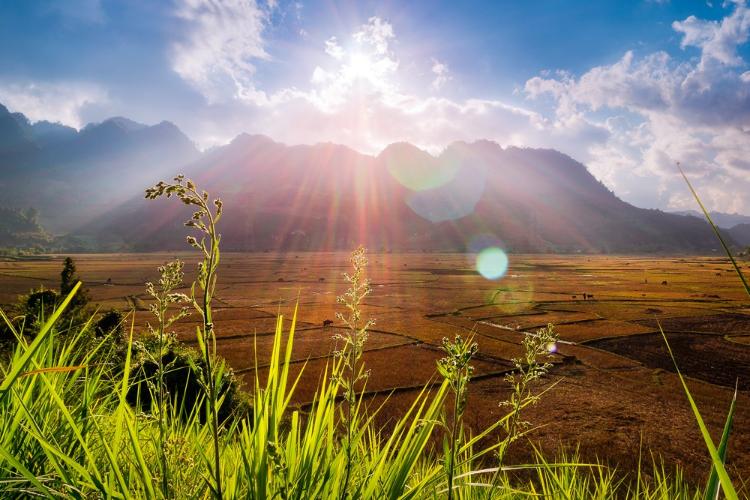Best Selling Products
Understanding Flare and its outstanding applications in photography
Nội dung
- 1.Introduction What is Flare?
- 2. Popular types of lens flare
- 2.1. Circle Flare Lens
- 2.2. Starburst Flare
- 2.3. Ghosting Flare
- 2.4. Halo Flare
- 3. Common uses of lens flare in photography
- 3.1. Increase the artistry and emotion of the photo
- 3.2. Create depth and vibrancy for images
- 3.3. Emphasize the light source
- 3.4. Evokes a sense of mystery or nostalgia
- 3.5. Increase contrast and highlights in dark scenes
- 4. How to control and use lens flare in photography
- 4.1. Use a lens hood
- 4.2. Choose the right shooting angle
- 4.3. Use high quality lenses
- 4.4. Experiment with light
- 5. Conclusion
Flare in photography is not just an accidental phenomenon but also a creative tool. Discover the definition of flare and common applications of lens flare in this detailed article.

Flare, also known as the phenomenon of light flare in photography, is an important element that helps create inspiring and artistic photos. This article sadesign will help you better understand what flare is and the common uses of lens flare in improving image quality.
1.Introduction What is Flare?
Flare, in the context of photography, is the phenomenon of strong light from a light source (such as the sun or a spotlight) reflecting off the camera lens, creating unwanted or intentional light streaks in the image. This usually happens when strong light hits the lens at a particular angle, overcoming the filtering and correction capabilities of the lens. However, flare is not always undesirable, in some cases it can even be a creative element, adding an artistic feel to the image.
.jpg)
When flare occurs, light not only reflects off the lens, but also spreads across the lens elements inside the lens, creating strange light streaks or rings in the photo. These streaks can reduce the contrast and detail of the image, making the photo look a bit blurry or “glossy”.
However, if used correctly, flare can be a powerful tool to enhance the artistry, making the photo more impressive and vivid. The important thing is to know how to control and create flare intentionally, instead of letting it happen randomly.
2. Popular types of lens flare
In photography, lens flare can appear in many different forms, depending on the type of light and the angle at which it hits the lens. Common types of flare include:
2.1. Circle Flare Lens
Lens Flare is a common optical phenomenon in photography and videography, which occurs when strong light shines directly into the lens, creating unique lighting effects. One of the common types of Lens Flare is Circle Flare. This is the phenomenon of concentric bright rings appearing, usually due to light being reflected multiple times between the lens surfaces inside the lens.
This effect not only brings visual beauty but is also used as an artistic element in many photographic and cinematic works. However, to control and effectively use the ring-shaped Lens Flare, the photographer needs to understand the lens structure, lighting angle and how to adjust the light appropriately to achieve the desired results without losing image quality.
2.2. Starburst Flare
Lens flare occurs when strong light hits the edges of the lens, causing rays of light to radiate out from the center of the light source. These rays can create a star-like appearance, giving the photo a shimmering, dimensional look.
.jpg)
The characteristics of the cone-shaped Lens Flare not only bring artistry to the photo but also require good control and light processing techniques from the photographer. Therefore, understanding and knowing how to take advantage of this effect can help photographers improve the quality and aesthetic value of their work.
2.3. Ghosting Flare
Ghosting flare occurs when bright light shines directly into the lens from an extremely bright light source. The light reflects between the lens elements in the lens causing a “ghost” effect – a blurry, unsharp image that creates a hazy feel to the photo.
This is the result of light not being fully controlled and causing unwanted reflections. Although Ghosting Flare can reduce image quality, in some cases, it is also used as an artistic effect to create a unique highlight for the photo. To limit this phenomenon, users can use a sun hood, adjust the shooting angle or choose lenses with high-quality anti-reflective coating.
2.4. Halo Flare
Halo flare is a phenomenon of light that creates a halo of light around the main light source, which can be circular or oval in shape. Halos often appear when strong light from the sun or street lights shines into the lens, causing a mysterious, hazy feeling to the photo.
This is a phenomenon that occurs when light forms concentric rings or faint streaks of light around the main light source. Halo flare often appears when using multi-layer lenses or when not using a lens hood to protect. Although sometimes lens flare can reduce image quality, when used creatively, it can create a unique artistic effect, adding aesthetics and emotion to a photo or video. Controlling and utilizing lens flare requires a deep understanding of the technique as well as practical experience of the photographer or videographer.
3. Common uses of lens flare in photography
While lens flare can degrade image quality if not properly controlled, when used intentionally, it can create beautiful, emotional, and artistic images. Here are some common uses of lens flare in photography:
.jpg)
3.1. Increase the artistry and emotion of the photo
One of the most common uses for lens flares is to create a unique and artistic look in your photos. Light trails, rings, or soft rays can make your photos more interesting and appealing. This is especially true when shooting outdoors at dawn or dusk, when the natural light is strong and can create dramatic flare effects.
3.2. Create depth and vibrancy for images
Lens flares can help make a photo more dynamic by adding depth and dimension. Light trails or halos can highlight an object or bright area in the frame, creating a lighting effect that adds a sense of space and depth. This can make a photo appear more dynamic and have more depth than a regular photo.
3.3. Emphasize the light source
When you want to highlight a light source in a photo, a lens flare can be an effective tool. For example, when photographing the sun , lamps or street lights, adding a little flare can help highlight the light source and make the photo more dramatic. Rays, rings or streaks of light can create a captivating effect, making the photo look “fresh” and full of energy.
3.4. Evokes a sense of mystery or nostalgia
Flares can create a mysterious or nostalgic feel to a photo. This is why many photographers often use flares when shooting cinematic or vintage photos. This subtle flare effect can make the photo look like a scene from a movie from the 70s or 80s, giving it a nostalgic or mysterious feel.
3.5. Increase contrast and highlights in dark scenes
In nighttime or low-light photography, lens flares can create a dramatic effect that highlights a subject or highlight in the photo. Light trails or halos can help brighten dark areas, while also creating strong contrasts that draw attention to important details in the frame.
4. How to control and use lens flare in photography
.jpg)
To use lens flare effectively, you need to understand how to control it and apply it correctly. Here are some tips for controlling flare in photography:
4.1. Use a lens hood
To avoid unwanted flare, you can use a lens hood to block light from entering the lens. This will help limit strong light from reflecting into the lens and causing random flare.
4.2. Choose the right shooting angle
Flares usually occur when strong light hits the lens at a particular angle. Therefore, you can adjust the angle of the shot so that the light does not hit the lens directly. However, if you want to create a flare on purpose, choosing an angle that hits the light in the right place will help you create a beautiful flare effect.
4.3. Use high quality lenses
Some lenses are more effective at reducing flare than others. High-quality lenses with anti-reflective coatings will help reduce unwanted flare.
4.4. Experiment with light
To create artistic flare photos, you need to experiment with different light sources. Try shooting in the sunlight at dawn or dusk, or use a powerful light source to create a flare. Pay attention to light trails and rings to get the most out of this effect.
5. Conclusion
Flare is an element that can make all the difference in photography, from creating creative and artistic effects to highlighting important details in a photo. Although it can degrade the quality of an image if not well controlled, when used purposefully, flare can create beautiful and emotional photos. Understanding what flare is and how to use it effectively will help photographers create impressive works of art, while expressing their creativity and unique artistic vision.












































